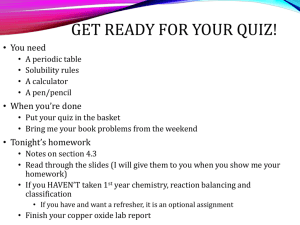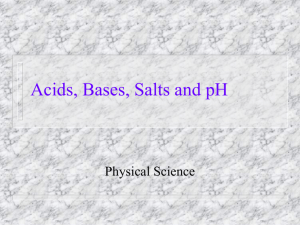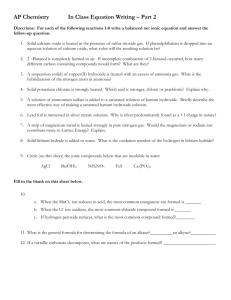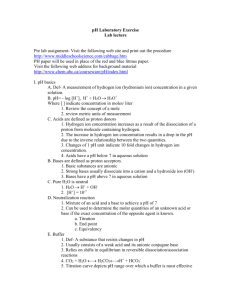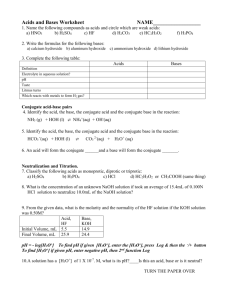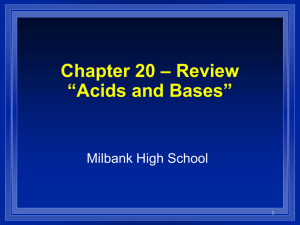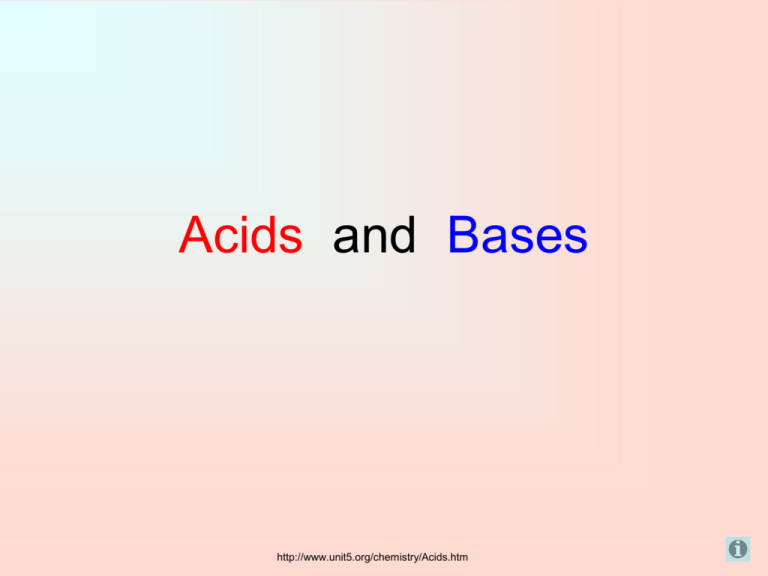
Acids and Bases
http://www.unit5.org/chemistry/Acids.htm
http://www.chalkbored.com/lessons/chemistry-11/acid-bronsted.ppt
pH scale: measures acidity/basicity
ACID
BASE
10x10x
100x 10x
0
1
2
3
4
5
6
7
8
9
10
11
12
13
14
NEUTRAL
Each step on pH scale represents a factor of 10.
pH 5 vs. pH 6
pH 3 vs. pH 5
pH 8 vs. pH 13
(10X more acidic)
(100X different)
(100,000X different)
pH scale: measures acidity/basicity
Søren Sorensen
(1868 - 1939)
ACID
BASE
10x10x
100x 10x
0
1
2
3
4
5
6
7
8
9
10
11
12
13
14
NEUTRAL
Each step on pH scale represents a factor of 10.
pH 5 vs. pH 6
pH 3 vs. pH 5
(10X more acidic)
(100X different)
Acid vs. Base
Different
Alike
pH < 7
Affects pH
and
litmus paper
Topic
sour taste
react with
metals
Acid
Different
pH > 7
Topic
Related to
H+ (proton)
concentration
pH + pOH = 14
Base
bitter taste
does not
react with
metals
Properties
electrolytes
electrolytes
sour taste
bitter taste
turn litmus red
turn litmus blue
react with metals to
form H2 gas
slippery feel
vinegar, milk, soda,
apples, citrus fruits
ammonia, lye, antacid,
baking soda
ChemASAP
Common Acids and Bases
Strong Acids (strong electrolytes)
HCl
HNO3
HClO4
H2SO4
hydrochloric acid
nitric acid
perchloric acid
sulfuric acid
Strong Bases (strong electrolytes)
NaOH
KOH
Ca(OH)2
sodium hydroxide
potassium hydroxide
calcium hydroxide
Weak Base (weak electrolyte)
Weak Acids (weak electrolytes)
CH3COOH
H2CO3
acetic acid
carbonic
NH3
NH4OH
ammonia
ammonia
NH3 + H2O NH4OH
Kotz, Purcell, Chemistry & Chemical Reactivity 1991, page 145
Acid + Base Salt + Water
HCl + NaOH NaCl + HOH
salt
water
Neutralization
Neutralization is a chemical reaction between an acid and a base
to produce a salt (an ionic compound) and water.
NaOH(aq) + HCl(aq)
base
acid
NaCl(aq) + H2O(l)
salt
water
Some neutralization reactions:
H2SO4(aq) + 2 NaOH(aq)
sulfuric acid
2 HC2H3O2(aq) +
acetic acid
sodium hydroxide
Ca(OH)2(aq)
calcium hydroxide
Na2SO4 +
sodium sulfate
2 HOH
water
Ca(C2H3O2)2 + 2 HOH
calcium acetate
water
Acid-Base Neutralization
1-
1+
+
+
H32O+
OH
H2O-
H2O
H2O
Water ion
Hydronium
Hydroxide
Water ion
Water
Water
Dorin, Demmin, Gabel, Chemistry The Study of Matter 3rd Edition, page 584
Acid-Base Neutralization
1-
1+
+
+
H3O+
OH-
H2O
H2O
Hydronium ion
Hydroxide ion
Water
Water
Dorin, Demmin, Gabel, Chemistry The Study of Matter 3rd Edition, page 584
Acid Precipitation
http://nadp.sws.uiuc.edu/amaps2/
Formation of Sulfuric Acid
+
+
SO2(g) + H2O(l)
H2SO3(aq)
2SO2(g) + O2(g)
2SO3(g)
SO3(g) + H2O(l)
H2SO4(aq)
Sulfuric acid
Catalyzed by atmospheric dust
SO2(g) + H2O2(l)
Kelter, Carr, Scott, Chemistry A World of Choices 1999, page 302
H2SO4(aq)
Hydrogen ion concentration as pH from measurements
made
at the
field laboratories
during 2003
made
at the
Central
Analytical Laboratory,
1999
The progressively darker red areas on the map indicate the lowest pH levels
and areas most prone to problems from acid rain.
National Atmospheric Deposition Program/National Trends Network
http://nadp.sws.uiuc.edu
Figure courtesy of the National Atmospheric Deposition Program, Champaign, Ill.
Acid Rain
Estimated sulfate ion deposition, 1999
Smoke stacks pollute SO2
into the atmosphere. This
combines with water to form
acid rain.
CO2 (g)
H2O (l)
H2CO3 (aq)
Carbon
dioxide
Water
Carbonic
acid
Weak
acid
Copyright © 2007 Pearson Benjamin Cummings. All rights reserved.
Common Acids
Sulfuric Acid
H2SO4
Battery acid
Nitric Acid
HNO3
Used to make fertilizers
and explosives
Phosphoric Acid
H3PO4
Food flavoring
Hydrochloric Acid
HCl
Stomach acid
Acetic Acid
Carbonic Acid
CH3COOH
H2CO3
Vinegar
Carbonated water
Common Acids
Formula
Name of Acid
Name of Negative
Ion of Salt
HF
HBr
HI
HCl
HClO
HClO2
HClO3
HClO4
H2S
H2SO3
H2SO4
HNO2
HNO3
H2CO3
H3PO3
H3PO4
hydrofluoric
hydrobromic
hydroiodic
hydrochloric
hypochlorous
chlorous
chloric
perchloric
hydrosulfuric
sulfurous
sulfuric
nitrous
nitric
carbonic
phosphorous
phosphoric
fluoride
bromide
iodide
chloride
hypochlorite
chlorite
chlorate
perchlorate
sulfide
sulfite
sulfate
nitrite
nitrate
carbonate
phosphite
phosphate
Formation of Hydronium Ions
1+
1+
1+
+
H+
H2O
hydrogen ion
(a proton)
water
H3O+
hydronium ion
Sulfuric Acid, H2SO4
Sulfuric acid is the most commonly produced industrial chemical in the world.
Uses: petroleum refining, metallurgy, manufacture of fertilizer,
many industrial processes: metals, paper, paint, dyes, detergents
Sulfuric acid is used in
automobile batteries.
H2SO4
“oil of vitriol”
Nitric Acid, HNO3
Nitric acid stains proteins yellow (like your skin).
Uses: make explosives, fertilizers, rubber, plastics, dyes, and pharmaceuticals.
HNO3
O
“aqua fortis”
H
N
O
O
Hydrochloric Acid, HCl
The stomach produces HCl to aid in the digestion of food.
Uses: For ‘pickling’ iron and steel.
Pickling is the immersion of metals in acid solution to remove
surface impurities.
A dilute solution of HCl is called muriatic acid (available in many hardware
stores). Muriatic acid is commonly used to adjust pH in swimming pools
and in the cleaning of masonry.
HCl(g) + H2O(l)
hydrogen chloride
water
HCl(aq)
hydrochloric acid
OH1-
Common Bases
hydroxide
ion
Name
Formula
Common Name
Sodium hydroxide
NaOH
lye or caustic soda
Potassium hydroxide
KOH
lye or caustic potash
Magnesium hydroxide
Mg(OH)2
milk of magnesia
Calcium hydroxide
Ca(OH) 2
slaked lime
Ammonia water
NH
H 2O
NH43.OH
household ammonia
NH41+ + OH1ammonium hydroxide
Relative Strengths of Acids and Bases
perchloric
hydrogen chloride
nitric
sulfuric
hydronium ion
hydrogen sulfate ion
phosphoric
acetic
carbonic
hydrogen sulfide
ammonium ion
hydrogen carbonate ion
water
ammonia
hydrogen
Metcalfe, Williams, Catska, Modern Chemistry 1966, page 229
Formula
HClO4
HCl
HNO3
H2SO4
H3O+
HSO4H3PO4
HC2H3O2
H2CO3
H2S
NH4+
HCO3H2O
NH3
H2
acid
Conjugate base
Formula
perchlorate ion
chloride ion
nitrate ion
hydrogen sulfate ion
water
sulfate ion
dihydrogen phosphate ion
acetate ion
hydrogen carbonate ion
hydro sulfide ion
ammonia
carbonate ion
hydroxide ion
amide ion
hydride ion
conjugate base + H+
ClO4ClNO3HSO4H2O
SO42H2PO4C2H3O2HCO3HSNH3
CO32OHNH2H-
Decreasing Base Strength
Decreasing Acid Strength
Acid
Binary Hydrogen Compounds
of Nonmetals When Dissolved in Water
(These compounds are commonly called acids.)
The prefix hydro- is used to represent hydrogen, followed by the name
of the nonmetal with its ending replaced by the suffix –ic and the word
acid added.
Examples:
*HCl
Hydrochloric acid
HBr
Hydrobromic acid
*The name of this compound would be hydrogen chloride if it was NOT dissolved in water.
Naming Ternary Compounds
from Oxyacids
The following table lists the most common families of oxy acids.
one more
oxygen atom
HClO4
perchloric acid
most
“common”
HClO3
chloric acid
H2SO4
sulfuric acid
H3PO4
phosphoric acid
HNO3
nitric acid
one less
oxygen
HClO2
chlorous acid
H2SO3
sulfurous acid
H3PO3
phosphorous acid
HNO2
nitrous acid
two less
oxygen
HClO
hypochlorous acid
H3PO2
hypophosphorous acid
(HNO)2
hyponitrous acid
An acid with a
name ending in
A salt with a
name ending in
-ous
forms
-ite
-ic
forms
-ate
Hill, Petrucci, General Chemistry An Integrated Approach 1999, page 60
Oxyacids Oxysalts
If you replace hydrogen with a metal, you have formed an oxysalt.
A salt is a compound consisting of a metal and a non-metal. If the
salt consists of a metal, a nonmetal, and oxygen it is called an
oxysalt. NaClO4, sodium perchlorate, is an oxysalt.
OXYACID
OXYSALT
HClO4
perchloric acid
NaClO4
sodium perchlorate
HClO3
chloric acid
NaClO3
sodium chlorate
HClO2
chlorous acid
NaClO2
sodium chlorite
HClO
hypochlorous acid
NaClO
sodium hypochlorite
ACID
SALT
per stem ic
changes to
per stem ate
stem ic
changes to
stem ate
stem ous
changes to
stem ite
hyper stem ous
changes to
hypo stem ite
HClO3
acid
+
Na1+
cation
NaClO3 + H1+
salt
Acid Definitions
Lewis Acid
Brønsted-Lowry
Arrhenius
acids
Arrhenius Acids and Bases
Acids release hydrogen ions in water.
Bases release hydroxide ions in water.
An acid is a substance that produces hydronium ions, H3O+,
when dissolved in water.
Brønsted-Lowry Definitions
A Brønsted-Lowry acid is a proton donor; it donates a hydrogen ion, H+.
A Brønsted-Lowry base is a proton acceptor; it accepts a hydrogen ion, H+.
Lewis Definitions
A Lewis acid is a substance than can accept (and share) an electron pair.
A Lewis base is a substance than can donate (and share) an electron pair.
Acid – Base Systems
Type
Acid
Base
Arrhenius
H+ or H3O +
producer
OH - producer
BrønstedLowry
Lewis
Proton (H +)
donor
Proton (H +)
acceptor
Electron-pair
acceptor
Electron-pair
donor
Arrhenius Acid
Any substance that releases H+ ions as the
only positive ion in the aqueous solution.
1-
1+
+
+
HCl
H2O
H3O+
Cl-
hydrogen chloride
(an Arrhenius acid)
water
hydronium ion
chloride ion
Definitions
• Arrhenius - In aqueous solution…
• Acids form hydronium ions (H3O+)
HCl + H2O H3O+ + Cl–
H
H
Cl
O
H
O
H
H
–
+
Cl
H
acid
Courtesy Christy Johannesson www.nisd.net/communicationsarts/pages/chem
Definitions
• Arrhenius - In aqueous solution…
• Bases form hydroxide ions (OH-)
NH3 + H2O NH4 +
+
H
H
H
N
H
O
H
–
+
O
N
H
H
OH
H
H
base
Courtesy Christy Johannesson www.nisd.net/communicationsarts/pages/chem
H
Brønsted-Lowry Acids and Bases
Acid = any substance that donates a proton.
Base = any substance that accepts a proton.
d+
1-
1+
d-
+
HCl
H2O
H3O+
Cl-
(acid)
(base)
hydronium ion
chloride ion
Brønsted-Lowry Acids and Bases
Acid = any substance that donates a proton.
Base = any substance that accepts a proton.
d+
1-
1+
d-
+
HCl
H2O
H3O+
Cl-
(acid)
(base)
hydronium ion
chloride ion
Definitions
• Brønsted-Lowry
• Acids are proton (H+) donors.
• Bases are proton (H+) acceptors.
HCl + H2O
acid
–
Cl
+
+
H3O
base
conjugate base
conjugate acid
Courtesy Christy Johannesson www.nisd.net/communicationsarts/pages/chem
Definitions
Give the conjugate base for each of the following:
HF
F-
H3PO4
H2PO4-
H3O+
H 2O
Polyprotic
- an acid with more than one H+
Courtesy Christy Johannesson www.nisd.net/communicationsarts/pages/chem
pH of Common Substances
gastric
juice
1.6
vinegar
2.8
carbonated
beverage
3.0
0
1
2
acidic
Timberlake, Chemistry 7th Edition, page 335
urine
6.0
4
5
bile
8.0
6
7
neutral
[H+] = [OH-]
8
ammonia
11.0
bleach
12.0
seawater
8.5
9
1.0 M
NaOH
(lye)
14.0
milk of
magnesia
10.5
detergents
8.0 - 9.0
milk
6.4
tomato
4.2
coffee
5.0
3
blood
7.4
potato
5.8
apple juice
3.8
lemon
juice
2.2
drinking water
7.2
bread
5.5
orange
3.5
1.0 M
HCl
0
water (pure)
7.0
soil
5.5
10
11
basic
12
13
14
pH of Common Substance
More acidic
More basic
pH
NaOH, 0.1 M
Household bleach
Household ammonia
Lime water
Milk of magnesia
Borax
Baking soda
Egg white, seawater
Human blood, tears
Milk
Saliva
Rain
Black coffee
Banana
Tomatoes
Wine
Cola, vinegar
Lemon juice
Gastric juice
14
13
12
11
10
9
8
7
76
5
4
3
2
1
0
[H1+]
[OH1-]
pOH
1 x 10-14
1 x 10-13
1 x 10-12
1 x 10-11
1 x 10-10
1 x 10-9
1 x 10-8
1 x 10-7
1 x 10-6
1 x 10-5
1 x 10-4
1 x 10-3
1 x 10-2
1 x 10-1
1 x 100
1 x 10-0
1 x 10-1
1 x 10-2
1 x 10-3
1 x 10-4
1 x 10-5
1 x 10-6
1 x 10-7
1 x 10-8
1 x 10-9
1 x 10-10
1 x 10-11
1 x 10-12
1 x 10-13
1 x 10-14
0
1
2
3
4
5
6
8
9
10
11
12
13
14
pH Calculations
pH
pH = -log[H3O+]
[H3O+]
[H3O+] = 10-pH
[H3O+] [OH-] = 1 x10-14
pH + pOH = 14
pOH
pOH = -log[OH-]
[OH-]
[OH-] = 10-pOH
pH = - log [H+]
Given: pH = 4.6
pH = - log [H+]
choose proper equation
4.6 = - log [H+]
substitute pH value in equation
- 4.6 =
2nd
log
determine the [hydronium ion]
- 4.6 =
log [H+]
log [H+]
[H+] = 2.51x10-5 M
multiply both sides by -1
take antilog of both sides
Recall, [H+] = [H3O+]
10x
antilog
You can check your answer by working backwards.
pH = - log [H+]
pH = - log [2.51x10-5 M]
pH = 4.6
Acid Dissociation
monoprotic
e.g. HCl, HNO3
HA(aq)
0.03 M
H1+(aq) + A1-(aq)
0.03 M
0.03 M
pH = ?
pH = - log [H+]
pH = - log [0.03M]
pH = 1.52
diprotic
e.g. H2SO4
H2A(aq)
0.3 M
2 H1+(aq) + A2-(aq)
0.6 M
0.3 M
pH = - log [H+]
pH = - log [0.6M]
pH = 0.22
polyprotic
e.g. H3PO4
H3PO4(aq)
?M
3 H1+(aq) + PO43-(aq)
xM
Given: pH = 2.1
find [H3PO4]
assume 100%
dissociation
Given: pH = 2.1
3 H1+(aq) + PO43-(aq)
0.00794 M
H3PO4(aq)
XM
find [H3PO4]
assume 100%
dissociation
Step 1) Write the dissociation of phosphoric acid
Step 2) Calculate the [H+] concentration
pH = - log [H+]
[H+] = 10-pH
2.1 = - log [H+]
[H+] = 10-2.1
- 2.1 = log [H+]
[H+] = 0.00794 M
2nd
7.94 x10-3 M
log
- 2.1 =
2nd
log log [H+]
[H+] = 7.94 x10-3 M
Step 3) Calculate [H3PO4] concentration
Note: coefficients (1:3) for (H3PO4 : H+)
7.94 x10-3 M = 0.00265 M H PO
3
4
3
How many grams of magnesium hydroxide are needed to add to 500 mL of H2O
to yield a pH of 10.0?
Step 1) Write out the dissociation of magnesium hydroxide
Mg(OH)2(aq)
-4 M
0.5
5 x10-5
Step 2) Calculate the pOH
Step 3) Calculate the [OH1-]
Mg2+(aq) + 2 OH1-(aq)
1 x10-4 M
Mg2+ OH1Mg(OH)2
pH + pOH = 14
10.0 + pOH = 14
pOH = 4.0
pOH = - log [OH1-]
[OH1-] = 10-OH
[OH1-] = 1 x10-4 M
Step 4) Solve for moles of Mg(OH)2
x mol
mol
5 x10 -5 M
0.5 L
L
Step 5) Solve for grams of Mg(OH)2
M
x g Mg(OH)2 = 2.5 x 10-5 mol Mg(OH)2
x = 2.5 x 10-5 mol Mg(OH)2
58 g Mg(OH)2
= 0.00145 g Mg(OH)2
1 mol Mg(OH)2
pH Paper
pH 0
1
2
3
4
5
6
pH 7
8
9
10
11
12
13
Red Cabbage Indicator
Copyright © 2007 Pearson Benjamin Cummings. All rights reserved.
How to read a buret volume
23
24.55 mL?
23.45 mL
(not 24.55 mL)
24
Titration
standard solution
• Titration
– Analytical method in which
a standard solution is
used to determine the
concentration of an
unknown solution.
unknown solution
Courtesy Christy Johannesson www.nisd.net/communicationsarts/pages/chem
Titration
• Equivalence point (endpoint)
– Point at which equal amounts of
H3O+ and OH- have been added.
– Determined by…
• indicator color change
• dramatic change in pH
Courtesy Christy Johannesson www.nisd.net/communicationsarts/pages/chem

